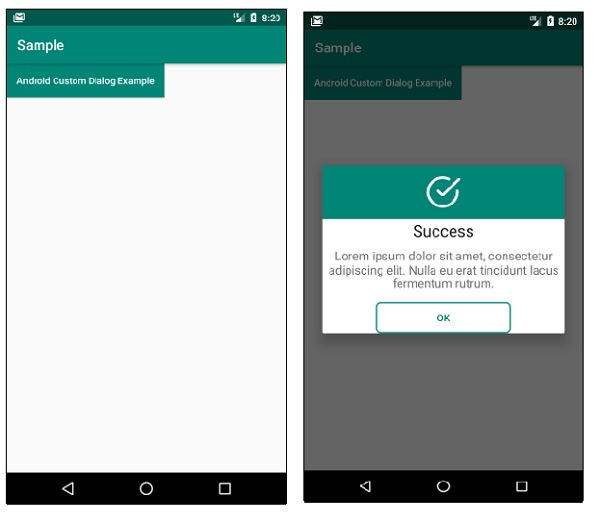
 Data Structure
Data Structure Networking
Networking RDBMS
RDBMS Operating System
Operating System Java
Java MS Excel
MS Excel iOS
iOS HTML
HTML CSS
CSS Android
Android Python
Python C Programming
C Programming C++
C++ C#
C# MongoDB
MongoDB MySQL
MySQL Javascript
Javascript PHP
PHP
- Selected Reading
- UPSC IAS Exams Notes
- Developer's Best Practices
- Questions and Answers
- Effective Resume Writing
- HR Interview Questions
- Computer Glossary
- Who is Who
How to implement a custom AlertDialog View in Android?
This example demonstrates how to implement a custom AlertDialog View in Android.
Step 1 − Create a new project in Android Studio, go to File ⇒ New Project and fill all required details to create a new project.
Step 2 − Add the following code to res/layout/activity_main.xml.
<?xml version="1.0" encoding="utf-8"?> <androidx.constraintlayout.widget.ConstraintLayout xmlns:android="http://schemas.android.com/apk/res/android" xmlns:app="http://schemas.android.com/apk/res-auto" xmlns:tools="http://schemas.android.com/tools" android:layout_width="match_parent" android:layout_height="match_parent" tools:context=".MainActivity"> <Button android:id="@+id/buttonShowDialog" android:layout_width="wrap_content" android:layout_height="wrap_content" android:layout_centerInParent="true" android:background="@color/colorPrimary" android:padding="15dp" android:text="Android Custom Dialog Example" android:textAllCaps="false" android:textColor="#ffffff" /> </androidx.constraintlayout.widget.ConstraintLayout>
Step 3 − Add the following code to res/layout/my_dialog.xml.
<?xml version="1.0" encoding="utf-8"?> <LinearLayout xmlns:android="http://schemas.android.com/apk/res/android" android:orientation="vertical" android:layout_width="match_parent" android:layout_height="match_parent"> <RelativeLayout android:layout_width="match_parent" android:layout_height="80dp" android:background="@color/colorPrimary"> <ImageView android:layout_width="50dp" android:layout_height="50dp" android:layout_centerInParent="true" android:background="@drawable/ic_success" /> </RelativeLayout> <TextView android:layout_width="match_parent" android:layout_height="wrap_content" android:text="Success" android:textAlignment="center" android:textAppearance="@style/TextAppearance.AppCompat.Headline"/> <TextView android:layout_width="match_parent" android:layout_height="wrap_content" android:layout_marginTop="10dp" android:text="Lorem ipsum dolor sit amet, consectetur adipiscing elit. Nulla eu erat tincidunt lacus fermentum rutrum." android:textAlignment="center" android:textAppearance="@style/TextAppearance.AppCompat.Medium"/> <Button android:id="@+id/buttonOk" android:layout_width="200dp" android:layout_height="wrap_content" android:layout_gravity="center" android:layout_marginTop="15dp" android:background="@drawable/button_background" android:text="Ok" android:textColor="@color/colorPrimary" /> </LinearLayout>
Step 4 − Add the following code to res/drawable/button_background.xml.
<?xml version="1.0" encoding="utf-8"?> <selector xmlns:android="http://schemas.android.com/apk/res/android"> <item> <shape> <stroke android:width="2dp" android:color="@color/colorPrimary" /> <solid android:color="@android:color/transparent" /> <corners android:bottomLeftRadius="6dp" android:bottomRightRadius="6dp" android:topLeftRadius="6dp" android:topRightRadius="6dp" /> </shape> </item> </selector>
Step 5 − Add the following code to res/drawable/ic_success.xml.
<?xml version="1.0" encoding="utf-8"?> <vector xmlns:android="http://schemas.android.com/apk/res/android" android:height="24dp" android:viewportHeight="512" android:viewportWidth="512" android:width="24dp"> <path android:fillColor="#FFFFFF" android:pathData="M468.907,214.604c-11.423,0 -20.682,9.26 -20.682,20.682v20.831c-0.031,54.338 -21.221,105.412 -59.666,143.812c38.417,38.372 -89.467,59.5 -143.761,59.5c-0.04,0 -0.08,0 -0.12,0C132.506,459.365 41.3,368.056 41.364,255.883c0.031, -54.337 21.221,-105.411 59.667,-143.813c38.417,- 38.372 89.468,-59.5 143.761, -59.5c0.04,0 0.08,0 0.12,0c28.672,0.016 56.49,5.942 82.68,17.611c10.436,4.65 22.659, -0.041 27.309,-10.474c4.648,-10.433 -0.04,-22.659 - 10.474,-27.309c-31.516,-14.043 -64.989,-21.173 -99.492,-21.192c-0.052,0 -0.092,0 - 0.144,0c-65.329,0 -126.767,25.428 -172.993,71.6C25.536,129.014 0.038,190.473 0,255.861c-0.037,65.386 25.389,126.874 71.599, 173.136c46.21,46.262 107.668,71.76 173.055,71.798c0.051,0 0.092,0 0.144,0c65.329,0 126.767, -25.427 172.993,-71.6c46.262,-46.20971.76,-107.66871.798,-173.066v20.842C489.589, 223.864 480.33,214.604 468.907,214.604z"/> <path android:fillColor="#FFFFFF" android:pathData="M505.942,39.803c-8.077,- 8.076 -21.172,-8.076 -29.249,0L244.794,271.701l-52.609,-52.609c-8.076,-8.077 -21.172,-8.077 -29.248,0c-8.077,8.077 -8.077,21.172 0,29.249l67.234,67.234c4.038,4.0399.332,6.058 14.625,6.058c5.293,0 10.586,-2.019 14.625, -6.058L505.942,69.052C514.019,60.975 514.019,47.88 505.942,39.803z"/> </vector>
Step 6 − Add the following code to src/MainActivity.java
package com.app.sample;
import androidx.appcompat.app.AlertDialog;
import androidx.appcompat.app.AppCompatActivity;
import android.os.Bundle;
import android.os.Bundle;
import android.view.LayoutInflater;
import android.view.View;
import android.view.ViewGroup;
public class MainActivity extends AppCompatActivity {
@Override
protected void onCreate(Bundle savedInstanceState) {
super.onCreate(savedInstanceState);
setContentView(R.layout.activity_main);
findViewById(R.id.buttonShowDialog).setOnClickListener(new
View.OnClickListener() {
@Override
public void onClick(View v) {
showCustomDialog();
}
});
}
private void showCustomDialog() {
ViewGroup viewGroup = findViewById(android.R.id.content);
View dialogView = LayoutInflater.from(this).inflate(R.layout.my_dialog, viewGroup, false);
AlertDialog.Builder builder = new AlertDialog.Builder(this);
builder.setView(dialogView);
AlertDialog alertDialog = builder.create();
alertDialog.show();
}
}
Step 7 − Add the following code to Manifests/AndroidManifest.xml
<?xml version="1.0" encoding="utf-8"?> <manifest xmlns:android="http://schemas.android.com/apk/res/android" package="com.app.sample"> <application android:allowBackup="true" android:icon="@mipmap/ic_launcher" android:label="@string/app_name" android:roundIcon="@mipmap/ic_launcher_round" android:supportsRtl="true" android:theme="@style/AppTheme"> <activity android:name=".MainActivity"> <intent-filter> <action android:name="android.intent.action.MAIN" /> <category android:name="android.intent.category.LAUNCHER" /> </intent-filter> </activity> </application> </manifest>
Let's try to run your application. I assume you have connected your actual Android Mobile device with your computer. To run the app from the android studio, open one of your project's activity files and click Run ![]() icon from the toolbar. Select your mobile device as an option and then check your mobile device which will display your default screen −
icon from the toolbar. Select your mobile device as an option and then check your mobile device which will display your default screen −

Click here to download the project code.

